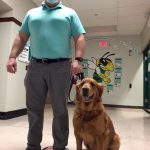Conditions For Canine Health
May 20, 2020

Corneal health starts at the adnexa of the eye. Every eye exam should begin with a thorough gross examination of the patient at rest, along with appropriate preliminary diagnostics. Good eyelid conformation, as well as appropriate tear production and quality, are crucial for the lasting health of the cornea. There are many breed related conditions, especially in the dog, that should be addressed by a veterinary ophthalmologist early on for treatment to prevent the development of corneal damage and promote the lasting health of the cornea. The following are some examples of such conditions:
Keratoconjunctivitis Sicca (KCS) is a quantitative tear film deficiency disorder that is most commonly seen in dogs as an immune mediated condition. KCS can also be neurogenic, drug-induced, or secondary to systemic disease, such as distemper or other metabolic diseases, such as hypothyroidism, diabetes mellitus, or Cushing’s disease. This is a common disorder diagnosed in dogs, which is why it is crucial to perform a Schirmer Tear Test (STT) on every patient presenting with an ocular complaint. In a normal dog, a STT should exceed 15mm in 60 sec. Diagnosis of KCS is based on a STT of <10mm/min; however, a STT of 11-14 mm/min is suspicious of the disorder. Clinical manifestations of KCS include conjunctival hyperemia, mucoid to muco-purulent discharge, keratitis, blepharitis, and even corneal ulceration. Patients with underlying systemic disease, such as diabetes mellitus, are at an even higher risk of developing severe corneal ulceration due to presence of decreased corneal sensitivity in addition to KCS. Therapy for KCS includes lacrimostimulants (i.e., Cyclosporine A or Tacrolimus), lacrimomimetics (i.e., HA containing ophthalmic ointments), prophylactic antimicrobials, mucinolytic agents (i.e., Acetylcysteine), and anti-inflammatories (i.e., topical steroids, if no concurrent ulceration is present). The use of tear replacement ointments containing HA or cross-linked HA can be helpful in the prevention of severe corneal ulcerations in these cases, especially during the initial four weeks of treatment due to the delayed onset of action of the lacrimostimulants. Severe cases, such as neurogenic KCS or cases which are refractory to medical management, may ultimately require a Parotid Duct Transposition in order to maintain appropriate lubrication of the cornea to prevent the development of severe corneal ulcers secondary to KCS.
Euryblepharon (aka Macropalpebral Fissure) is a congenital condition where the eyelid fissure is larger than normal and causes increased scleral exposure. This condition is commonly seen in both large breed dogs and small brachycephalic dogs. Euryblepharon is commonly associated with lagophthalmos, pigmentary keratitis (brachycephalic dogs), and entropion/ectropion (large breed dogs). In canines, the length of the eyelid fissure when stretched should measure approximately 33 mm. For the diagnosis of euryblepharon, the fissure will measure 5 to 15 mm longer. Referral to a veterinary ophthalmologist is recommended for evaluation and surgical correction, which might involve a medial and/or lateral canthoplasty, keeping in mind that other more extensive blepharoplasty procedures might be indicated depending on the severity of the condition. Eye lubrication with HA-containing ophthalmic ointments can be helpful in the management of severe cases, or cases where lagophthalmos is present, until the condition is able to be surgically corrected.
Ectropion is a developmental condition where the eyelid margin is everted. This condition is most commonly seen along the inferior lid and is often diagnosed in large and medium breed dogs with accompanying secondary euryblepharon or canthal ligament laxity. Ectropion can also be an acquired condition often caused by other disease processes such as facial nerve paralysis, scar tissue formation secondary to previous trauma, or overcorrection from a previous entropion surgery. Ectropion predisposes the cornea to exposure keratitis, which can ultimately lead to corneal ulceration. Referral to a veterinary ophthalmologist for evaluation and appropriate surgical correction is recommended.
Entropion is most commonly a developmental condition where the eyelid margin is inverted, potentially leading to secondary trichiasis, blepharospasm, epiphora, enophthalmos, secondary conjunctivitis, and ulcerative keratitis. Entropion is frequently seen in young, large breed dogs secondary to their eyelid conformation; however, it can also be an acquired condition secondary to marked blepharospasm. Entropion arises due to excessive eyelid length (i.e. euryblepharon), lack of support of the eyelids by the globe (i.e. enophthalmos, microphthalmos, phthisis bulbi), excessive skin on the forehead and subsequent upper lid ptosis, and increased tone of the orbicularis oculi muscle (i.e. spastic entropion). Referral to a veterinary ophthalmologist is recommended for evaluation and surgical correction via the Hotz-Celsus surgical technique, and/or more extensive blepharoplasty procedures depending on the extent of the condition. Puppies can also develop a transient entropion during growth. The use of temporary tacking sutures can be utilized to save the cornea while they are growing. Permanent procedures are recommended if the entropion persists once they are full grown.
Trichiasis is a developmental condition where the eyelid hairs, or facial hairs, are abnormally positioned towards the cornea. This is especially common in brachycephalic breeds. Clinical manifestations include epiphora, pigmentary keratitis, chronic conjunctival hyperemia, and occasionally corneal ulceration. For severe cases, referral to a veterinary ophthalmologist is recommended for evaluation and appropriate surgical correction depending on the type of trichiasis that is present. Some less severe cases may be able to be managed successfully with the long-term use of eye lubrication using HA-containing ointments and proper grooming.
Distichiasis is a condition where there is abnormal growth of cilia through the meibomian gland openings of the eyelid margin. It is one of the most common inherited eyelid diseases in the dog and can involve both the upper and lower eyelid, and can be a unilateral or bilateral disease. Distichiasis can be difficult to appreciate without the use of biomicroscopic examination. Some of these cases can be subclinical; however, if there is resulting keratitis, then referral to a veterinary ophthalmologist for evaluation and potential cryoepilation or electroepilation of the abnormal cilia is recommended.
Ectopic Cilia is a condition where there is abnormal growth of cilia through the palpebral conjunctiva. Ectopic cilia can appear on the superior or inferior eyelid and can involve one or both eyes. Clinical manifestations include blepharospasm, increased blink rate, epiphora, and are commonly associated corneal ulceration. Diagnosis of this condition can be challenging and requires the use of biomicroscopic examination. Treatment includes referral to a veterinary ophthalmologist for en-bloc resection +/- cryotherapy of the abnormal cilia due to the high likelihood of corneal ulceration and ocular pain that they can cause.


 When Luke Hengen’s diabetes worsened in his early twenties, it stripped him of the outdoor activities where the country kid felt at home. Countless wilderness adventures and years of hard-fought football games took a toll on his body, to the point where he could no longer sense when his blood sugar was too high or […]
When Luke Hengen’s diabetes worsened in his early twenties, it stripped him of the outdoor activities where the country kid felt at home. Countless wilderness adventures and years of hard-fought football games took a toll on his body, to the point where he could no longer sense when his blood sugar was too high or […] When middle school students return to class on Jan. 11, they’ll find a new face at the door: Daisy. Daisy is a therapy dog and the personal pet of Rob Kreger, principal of the Rock L. Butler Middle School. The five-year-old golden retriever is not a school pet or mascot, but rather a working dog […]
When middle school students return to class on Jan. 11, they’ll find a new face at the door: Daisy. Daisy is a therapy dog and the personal pet of Rob Kreger, principal of the Rock L. Butler Middle School. The five-year-old golden retriever is not a school pet or mascot, but rather a working dog […] Last March, Caroline Benzel, a third-year medical student, began to notice the stress and discomfort her nurse friends were feeling from the pressures of the ongoing Covid-19 pandemic. “[Personal protective equipment] can be really rough on the skin,” Benzel, 31, tells PEOPLE. Benzel and her 3-year-old Rottweiler, Loki (who’s also a therapy dog) hatched a […]
Last March, Caroline Benzel, a third-year medical student, began to notice the stress and discomfort her nurse friends were feeling from the pressures of the ongoing Covid-19 pandemic. “[Personal protective equipment] can be really rough on the skin,” Benzel, 31, tells PEOPLE. Benzel and her 3-year-old Rottweiler, Loki (who’s also a therapy dog) hatched a […] When Stanley the miniature fox terrier’s owner passed away, the little dog started a ‘paw-some’ new role – bringing puppy love to some of the Gold Coast’s oldest residents. After Carinity Cedarbrook Diversional Therapist Julianne Staff adopted Stanley, he began visiting the aged care community at Mudgeeraba as a therapy dog. Therapy dogs help to […]
When Stanley the miniature fox terrier’s owner passed away, the little dog started a ‘paw-some’ new role – bringing puppy love to some of the Gold Coast’s oldest residents. After Carinity Cedarbrook Diversional Therapist Julianne Staff adopted Stanley, he began visiting the aged care community at Mudgeeraba as a therapy dog. Therapy dogs help to […] A nonprofit is providing an unusual form of therapy for those on the front lines of the coronavirus pandemic – puppy cams! “You spend five minutes with a puppy and try not to smile,” said registered nurse Robin Lingg Lagrone. Lingg Lagrone says watching little furballs wag their tails and prance on their paws helps […]
A nonprofit is providing an unusual form of therapy for those on the front lines of the coronavirus pandemic – puppy cams! “You spend five minutes with a puppy and try not to smile,” said registered nurse Robin Lingg Lagrone. Lingg Lagrone says watching little furballs wag their tails and prance on their paws helps […] When Moore County’s school doors were abruptly closed earlier in 2020, two- and four-legged volunteers from the Moore County Citizens’ Pet Responsibility Committee (PRC) were in their 12th year of presenting a six-session Pet Responsibility Education Program for fourth-graders. The PRC quickly shifted gears and placed its program materials online as part of a home […]
When Moore County’s school doors were abruptly closed earlier in 2020, two- and four-legged volunteers from the Moore County Citizens’ Pet Responsibility Committee (PRC) were in their 12th year of presenting a six-session Pet Responsibility Education Program for fourth-graders. The PRC quickly shifted gears and placed its program materials online as part of a home […]